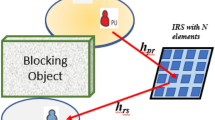Abstract
In this article, we suggest a new Spectrum Sensing (SS) algorithm using Incremental Relaying (IR). In previous studies, the relays always cooperate in the SS process. However, sometimes the Signal to Noise Ratio (SNR) of the direct link between the Primary User (PU) and the Fusion Node (FN) is high and cooperation is not required. We suggest to activate the relays only when the SNR of direct link is lower than a predefined threshold T. Otherwise, the relays should be idle. In the proposed SS algorithm with IR, all relays can amplify the PU signal to FN only when the SNR of direct link is lower than T. We can also implement IR with relay selection techniques. When the SNR of direct link is lower than T, we select the best relay. Three relay selection algorithms are investigated such as opportunistic amplify and forward, partial and reactive relay selection.






Similar content being viewed by others
References
Zheng, K., Liu, X.-Y., Liu, X., & Zhu, Y. (2019). Hybrid overlay-underlay cognitive radio networks with energy harvesting. IEEE Transactions on Communications, 67, 4669–4682.
Haykin, S. (2005). Cognitive radio: Brain-empowered wireless communications. IEEE Journal on Selected Areas in Communications, 23, 201–220.
Digham, F. F., Alouini, M. S., & Simon, M. K. (2007). On the energy detection of unknown signals over fading channels. IEEE Transactions on Communications, 55(1), 21–24.
Kim, J. H., & Choi, J. P. (2019). Sensing coverage-based cooperative spectrum detection in cognitive radio networks. IEEE Sensors Journal, 19, 5325–5332.
Kulkarni, K., Franchi, N., & Fettweis, G. (2019). Real-time cooperative spectrum sensing: Reliable localization of unknown interferers in shared spectrum. In 12th international ITG conference on systems, communications and coding (pp. 1–6).
Yuan, S., Li, L., & Chigan, C. (2019). On MMD-based secure fusion strategy for robust cooperative spectrum sensing. IEEE Transactions on Cognitive Communications and Networking, 5, 504–516.
Yang, T., Wu, Y., Li, L., Xu, W., & Tan, W. (2019). Fusion rule based on dynamic grouping for cooperative spectrum sensing in cognitive radio. IEEE Access, 7, 51630–51639.
Kumar, A., Saha, S., & Tiwari, K. (2019). A double threshold based cooperative spectrum sensing with novel hard-soft combining over fading channels. IEEE Wireless Communications Letters, 8, 1154–1158.
Biswas, S., Dey, S., & Shirazinia, A. (2019). Sum throughput maximization in a cognitive multiple access channel with cooperative spectrum sensing and energy harvesting. IEEE Transactions on Cognitive Communications and Networking, 5, 382–399.
Caso, G., De Nardis, L., Ferrante, G. C., & Di Benedetto, M. G. (2013). Cooperative spectrum sensing based on majority decision under CFAR and CDR constraints. In IEEE Personal Indoor and Mobile Radio Communications (PIMRC) (pp. 51–55).
Li, Z., yu, F., & Huang, M. (2009). A cooperative spectrum sensing consensus scheme in cognitive radio. In Processing INFOCOM (pp. 2546–2550).
Ganesa, G., & Li, Y. G. (2007). Cooperative spectrum sensing in cognitive radio, part I : Two user networks. IEEE Transactions on Wireless Communications, 6, 2204–2213.
Ganesa, G., & Li, Y. G. (2007). Cooperative spectrum sensing in cognitive radio, part II : Multiuser networks. IEEE Transactions on Wireless Communications, 6, 2204–2213.
Zhang, W., & Letaief, K. (2008). Cooperative spectrum sensing with transmit and relay diversity in cognitive radio networks. IEEE Transactions on Wireless Communications, 7(12), 4761–4766.
Ma, J., Zhao, G., & Li, Y. (2008). Soft combination and detection for cooperative spectrum sensing in cognitive radio networks. IEEE Transactions on Wireless Communications, 7(11), 4502–4507.
Atapattu, S., Tellambura, C., & Jiang, H. (2009). Relay based cooperative spectrum sensing in cognitive radio networks. In GLOBECOM 2009.
Atapattu, S., Tellambura, C., & Jiang, H. (2011). Energy detection based cooperative spectrum sensing in cognitive radio networks. IEEE Transactions on Wireless Communications, 4(10), 1232–1241.
Hamad, R. A., & Boujemaa, H. (2018). Cooperative spectrum sensing with relay selection. Telecommunication Systems, 68(4), 631–642.
Alhamad, R., Wang, H., & Yao, Y.-D. (2017). Cooperative spectrum sensing with random access reporting channels in cognitive radio networks. IEEE Transactions on Vehicular Technology, 66(8), 7249–7261.
Alhamad, R., Wang, H., & Yao, Y.-D. (2015). Reporting channel design and analysis in cooperative spectrum sensing for cognitive radio networks. In Vehicular Technology Conference (VTC) Fall (pp. 1–5).
Nuttall, A. H. (1974). Some integrals involving the QM function. Technical report, Naval Underwater systems Center (NUSC).
Boujemaa, H. (2010). Exact symbol error probability of cooperative systems with partial relay selection. European Transactions on Telecommunications, 21, 79–85.
Hasna, M., & Alouini, M. S. (2003). End-to-end performance of transmission systems with relays over Rayleigh fading channels. IEEE Transactions on Wireless Communications, 2, 1126–1131.
Hussain, S. I., Alouini, M. S., Qarage, K., & Hasna, M. (2012). Reactive relay selection in underlay cognitive networks with fixed gain relays. In IEEE international conference on communications 2012 (pp. 1784–1788).
Proakis, J. G. (1995). Digital communications (3rd ed.). New York City: Mc Graw Hill.
Acknowledgements
Funding was provided by The sincere appreciation for the deanship of Scientific research at Saudi Electronic University for funding this research.
Author information
Authors and Affiliations
Corresponding author
Ethics declarations
Conflict of interest
On behalf of all authors, the corresponding author states that there is no conflict of interest.
Additional information
Publisher's Note
Springer Nature remains neutral with regard to jurisdictional claims in published maps and institutional affiliations.
Appendix A: PDF of \(Z^{up}=\Gamma _{PD}+\Gamma _{PRD}^{up}|\Gamma _{PD}<T \)
Appendix A: PDF of \(Z^{up}=\Gamma _{PD}+\Gamma _{PRD}^{up}|\Gamma _{PD}<T \)
For Rayleigh fading channels and \(z<T ,\) we have
If \(z>T \),
Rights and permissions
About this article
Cite this article
Alhamad, R., Boujemaa, H. Cooperative spectrum sensing with incremental relaying. Telecommun Syst 74, 45–53 (2020). https://doi.org/10.1007/s11235-019-00632-1
Published:
Issue Date:
DOI: https://doi.org/10.1007/s11235-019-00632-1




